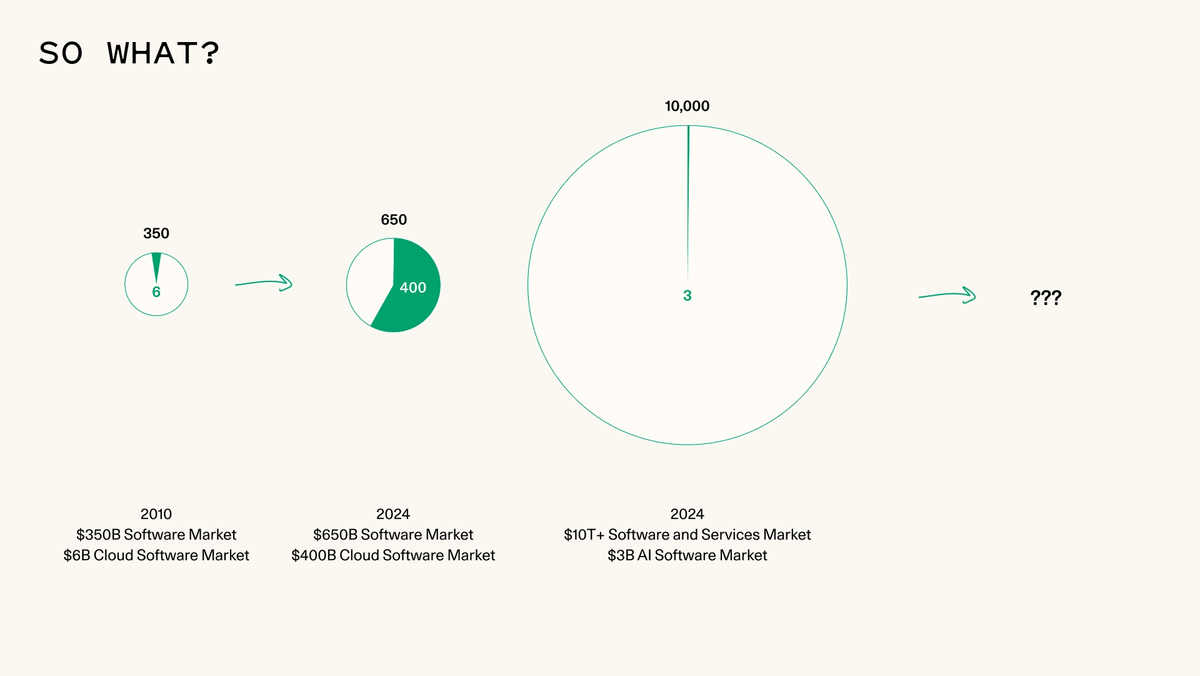Welcome to the dawn of the Web3 autonomous economy.
Author: 0xJeff
Compiled by: Deep Tide TechFlow
Every technological revolution gives rise to a brand new economic model:
Industrial Revolution ➔ Manufacturing Economy
Personal Computer ➔ Software Economy
Internet ➔ E-commerce Economy
Streaming ➔ Subscription Economy
Public Cloud ➔ SaaS (Software as a Service) Economy
iPhone ➔ App Economy
Social Media ➔ Creator Economy
Bitcoin and Blockchain ➔ Cryptocurrency/Web3 Economy ➔ Decentralized Finance (DeFi) Economy
Electric Vehicles ➔ Clean/Green Technology Economy
Artificial Intelligence/Machine Learning (AI/ML, Pre-trained Language Models) ➔ Predictive/Automated Economy
Large Language Models (LLMs) ➔ Autonomous Economy
The Rise of Giants
In these technological transformations, some giant companies always emerge, controlling a significant portion of the new economy:
Industrial Revolution: General Electric, Ford, Siemens, Caterpillar
Software Economy: Microsoft, IBM, Oracle, Adobe
E-commerce: Amazon, eBay, Alibaba, Shopify
Subscription Economy: Netflix, Spotify, Disney+, Hulu
SaaS Economy: AWS (Amazon Web Services), Microsoft Azure, Google Cloud, Salesforce, ServiceNow
App Economy: Apple, Google Play (Android), Tencent (WeChat), Meta (Instagram/WhatsApp)
Creator Economy: Meta (Facebook, Instagram), YouTube, TikTok, Patreon, Substack
Crypto Economy: Coinbase, Binance, Ethereum, Solana, Uniswap, Aave
Green Technology Economy: Tesla, BYD, Rivian, Lucid, ChargePoint, CATL (batteries)
Predictive/Automated Economy: Google DeepMind, Palantir, Nvidia, UiPath
Autonomous Economy: OpenAI, Anthropic, Grok, DeepSeek, Alibaba, Hugging Face
Disruptors' Entry Points
These giants attempt to predict and capture the next emerging economic field, but due to their size and strategic focus, they cannot cover all niche areas. This creates opportunities for smaller, more agile companies that can quickly experiment with ideas and focus on extremely niche markets:
Notion: Disrupting traditional enterprise collaboration and knowledge management tools (like Confluence, SharePoint)
Perplexity: Disrupting the search and information retrieval space (like Google Search, Wikipedia)
Substack: Disrupting traditional publishing and media industries (like blogs, newsrooms, Medium)
Grab/Uber: Disrupting urban transportation and logistics (like taxis, car rentals, delivery services)
Netflix: Disrupting cable TV and physical media (like Blockbuster, traditional broadcasting)
Airbnb: Disrupting the hotel and accommodation industry (like traditional hotels, travel agencies)
Amazon: Disrupting physical retail (like Walmart, local stores, Sears)
As these disruptors change the way industries operate, they themselves become new giants in their respective fields, creating opportunities for future emerging players to disrupt them again.
Autonomous Economy
In the autonomous economy, AI agents (Agentic AI) fundamentally change the way industries operate. These AI agents act as a digital workforce, capable of proactively completing tasks. Autonomous AI interfaces are now very common, significantly reducing the time users invest while enhancing productivity. This shift makes goods and services more efficient, especially in industries where humans perform repetitive tasks, as AI and AI agents can significantly lower costs and improve efficiency.
In the Web2 era, the best incubation platform and distribution network for showcasing AI and AI agent applications was @ycombinator, particularly prominent in recent batches of projects.
Midship: Using AI to scale financial auditing work
Cuckoo: Providing real-time AI translation for global sales, marketing, and support
Tempo: Helping designers and developers collaborate for 10x faster product delivery
Ascend: AI-based financial statement analysis platform
As large language models (LLMs) continue to improve, AI capabilities are enhanced, disrupting more industries, and increasingly more roles and responsibilities are being augmented or enhanced in productivity (not yet fully replaced).
Consumer AI is Brewing in Web3
In the Web2 era, Y Combinator served as the primary distribution network, incubating and promoting many high-quality AI startups. In the Web3 space, @virtuals_io is playing a similar role through the Agent Commerce Protocol (ACP). ACP is an open standard for commercial collaboration among multiple agents (AI agents), allowing these agents to call services, negotiate prices, execute tasks, provide evaluations, and more.
This mechanism gives rise to the Web3-driven Agentic Economy, where agents collaborate to create greater value for users. Autonomous hedge funds and autonomous media companies will be the first experimental projects of ACP, launching this entirely new economic system.
Trillion-Dollar Opportunity
As @sequoia stated:
“The core of cloud transformation is Software as a Service (SaaS). Software companies transform into cloud service providers, creating a $350 billion market opportunity. Thanks to Agentic Reasoning, the core of AI transformation is Service-as-a-Software. Software companies convert labor into software. This means the addressable market is no longer the software market, but the service market, which is worth trillions of dollars.”
Now, imagine the AI agent economy driven by Web3 capturing just a small portion of this approximately $10 trillion service market through crypto-native use cases (like trading, yield farming, i.e., crypto investment) and leveraging token incentives for accelerated growth; it will be a massive opportunity.

Source: Sequoia
Distribution Layer = Key to Victory
In the transition to the Agentic Economy, the distribution network/coordinating layer will become the biggest beneficiary. This is because crypto tokens become the core of the Web3 AI monetization model: users need to stake, burn, or hold tokens to access core agent products or use cases; tokens serve as the core currency for paying for computational resources and/or service fees.
This demand for tokens, along with the natural alignment of incentives between long-term supporters of projects and the projects themselves, means there will always be trading volume to capture, whether on decentralized exchanges (DEX) or on some token launch platforms. The distribution layer that can coordinate the autonomous economy and capture this trading volume will become a top player in this field, capturing a significant portion of the approximately $10 trillion market.
Welcome to the dawn of the Web3 autonomous economy. The future is here, bold and free—this is the era of the autonomous rise of Web3.
免责声明:本文章仅代表作者个人观点,不代表本平台的立场和观点。本文章仅供信息分享,不构成对任何人的任何投资建议。用户与作者之间的任何争议,与本平台无关。如网页中刊载的文章或图片涉及侵权,请提供相关的权利证明和身份证明发送邮件到support@aicoin.com,本平台相关工作人员将会进行核查。




